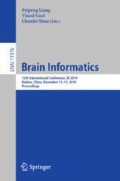Abstract
Neural feedback technology based on rt-fMRI (real-time functional Magnetic Resonance Imaging) provides a new non-invasive method to improve the cognitive function of the human brain, which achieves by training the human brain to regulate emotion. At the same time, brain network approaches based on graph theory is a hot spot. In this paper, we focus on the changes in the human brain’s small-world topology and network efficiency in graph theory before and after neurofeedback experiments. We designed an emotion self-regulation training with rt-fMRI, and acquired data from 20 participants, divided into the experimental group (EG) and the control group (CG). Subsequently, we constructed the brain network through the Anatomic Automatic Labelling (AAL) atlas, compared the topological changes of brain network between the EG and the CG in emotion self-regulation training. Our results show that both the EG and the CG have small-world topology, there are differences in small-world topology with emotion self-regulation training. Additionally, local efficiency is significantly different under certain sparsity, which suggests that emotional regulation has a positive effect on local networks. However, there is no significant difference in global efficiency, which means that the global network property does not change in emotion regulation training.
Access this chapter
Tax calculation will be finalised at checkout
Purchases are for personal use only
References
Bassett, D.S., Bullmore, E., Verchinski, B.A., Mattay, V.S., Weinberger, D.R., Meyer-Lindenberg, A.: Hierarchical organization of human cortical networks in health and schizophrenia. J. Neurosci. Off. J. Soc. Neurosci. 28(37), 9239–9248 (2008)
Bullmore, E., Sporns, O.: Complex brain networks: graph theoretical analysis of structural and functional systems. Nat. Rev. Neurosci. 10(3), 186–198 (2009)
Watts, D.J., Strogatz, S.H.: Collective dynamics of ‘small-world’ networks. Nature 393(6684), 440–442 (1998)
Colizza, V., Flammini, A., Serrano, M.A., Vespignani, A.: Detecting rich-club ordering in complex networks. Nat. Phys. 2, 110–115 (2006)
Boccaletti, S., Latora, V., Moreno, Y., et al.: Complex networks: structure and dynamics. Phys. Rep. 2006(424), 175–308 (2006)
Salvador, R., Suckling, J., Coleman, M.R., Pickard, J.D., Menon, D., Bullmore, E.: Neurophysiological architecture of functional magnetic resonance images of human brain. Cereb. Cortex 15(9), 1332–1342 (2005)
van den Heuvel, M.P., Stam, C.J., Kahn, R.S., et al.: Efficiency of functional brain networks and intellectual performance. J. Neurosci. 29, 7619–7624 (2009)
Ye, M., Yang, T., Peng, Q., Xu, L., Jiang, Q., Liu, G.: Changes of functional brain networks in major depressive disorder: a graph theoretical analysis of resting-state fMRI. PLoS ONE 10(9), e0133775 (2015)
Zhang, J.R., et al.: Disrupted brain connectivity networks in drug-naive, first-episode major depressive disorder. Biol. Psychiatry 70(4), 334–342 (2011)
Li, Z., et al.: Altered resting-state amygdala functional connectivity after real-time fMRI emotion self-regulation training. BioMed Res. Int. 2016 (2016). Article ID 2719895
Yan, C., Zang, Y.: DPARSF: a MATLAB toolbox for “pipeline” data analysis of resting-state fMRI. Front. Syst. Neurosci. 4, 13 (2010)
Tzourio-Mazoyer, N., Landeau, B., Papathanassiou, D., et al.: Automated anatomical labeling of activations in SPM using a macroscopic anatomical parcellation of the MNI MRI single-subject brain. Neuroimage 15(1), 273–289 (2002)
Wang, J., Wang, X., Xia, M.: Corrigendum: GRETNA: a graph theoretical network analysis toolbox for imaging connectomics. Front. Hum. Neurosci. 9, 386 (2015)
Qin, Y., Tong, L., Gao, H., Wang, L., Zeng, Y., Yan, B.: Research on functional brain networks topological properties by real-time fMRI emotion self-regulation training. In: 2018 IEEE 3rd International Conference on Signal and Image Processing (ICSIP), Shenzhen, pp. 86–90 (2018)
Suo, X., et al.: Disrupted brain network topology in pediatric posttraumatic stress disorder: a resting-state fMRI study. Hum. Brain Mapp. 36(9), 3677–3686 (2015)
Acknowledgment
This work was supported by the National Key Research and Development Plan of China under grant 2017YFB1002502, the National Natural Science Foundation of China (No. 61701089), and the Natural Science Foundation of Henan Province of China (No. 162300410333).
Author information
Authors and Affiliations
Corresponding author
Editor information
Editors and Affiliations
Rights and permissions
Copyright information
© 2019 Springer Nature Switzerland AG
About this paper
Cite this paper
Hu, L. et al. (2019). The Changes of Brain Networks Topology in Graph Theory of rt-fMRI Emotion Self-regulation Training. In: Liang, P., Goel, V., Shan, C. (eds) Brain Informatics. BI 2019. Lecture Notes in Computer Science(), vol 11976. Springer, Cham. https://doi.org/10.1007/978-3-030-37078-7_13
Download citation
DOI: https://doi.org/10.1007/978-3-030-37078-7_13
Published:
Publisher Name: Springer, Cham
Print ISBN: 978-3-030-37077-0
Online ISBN: 978-3-030-37078-7
eBook Packages: Computer ScienceComputer Science (R0)

